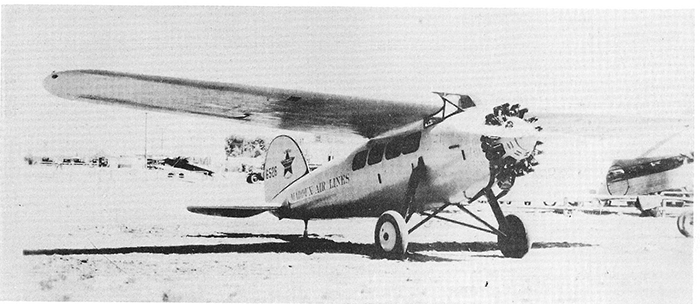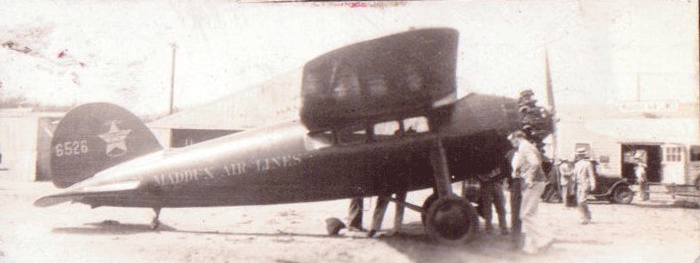OTHER RESOURCES
Some of this information comes from the listings of Non-Prefixed and Non-Suffixed aircraft reviewed by me in the archives of the National Air & Space Museum (NASM), Washington, DC.
---o0o---
YOU CAN HELP
I'm looking for information and photographs of this airplane to include on this page. If you have some you'd like to share, please click this FORM to contact me.
---o0o---
SPONSORED LINKS
HELP KEEP THESE WEB SITES ONLINE
FOR YOUR CONVENIENCE
You may NOW donate via PAYPAL by clicking the "Donate" icon below and using your credit card. You may use your card or your PAYPAL account. You are not required to have a PAYPAL account to donate.
When your donation clears the PAYPAL system, a certified receipt from Delta Mike Airfield, Inc. will be emailed to you for your tax purposes.
---o0o---
LOCKHEED VEGA NC6526
This airplane is a model Vega 1 manufactured July 6, 1928 by the Lockheed Aircraft Corporation, Burbank, CA. It was S/N 9, a very early airframe. It left the factory with a Wright Whirlwind J5C engine of 220HP, S/N 8554. It was a five-place aircraft weighing 2,900 pounds. It was sold on July 10, 1928 to Maddux Air Lines, Inc., Los Angeles, CA. Below is a photograph of NC6526 in Maddux livery, courtesy of this REFERENCE, page 113.
 |
Below, another image of 6526 in Maddux livery, courtesy of Tim Kalina.
 |
Like many Golden Age aircraft NC6526 had a short life (9 years), exchanged hands many times (10), and suffered its share of accidents (5). In fact, its first accident occurred within a year of its ownership by Maddux. On June 22, 1929, pilot Clarence Wood of Glendale, CA (not a Register pilot), fortunately carrying no passengers, wrecked the airplane in San Diego, CA. According to the reference linked above, Wood was taxiing to a hangar at San Diego and "dropped the [airplane] into a sandhole." There was slight damage to the engine, but the fuselage was "busted in half just aft of the passenger compartment." I have no information about the health of pilot Wood. But the airplane shipped back to Burbank and was ingeniously repaired using the fuselage of Vega S/N 42 (NC201E, not a Register airplane). A new Whirlwind engine was fitted (S/N 9269) and the airplane was signed off for flight on September 15, 1930, about a four-month down time.
Three months later NC6526 was sold to the Curtiss-Wright Flying Service, based at the Grand Central Air Terminal (GCAT). It is now that it shows up in the GCAT Register. NC6526 landed 33 times at GCAT during the six-month period December, 1930-May, 1931. It was flown by Mason Menefee, Harold Sweet, two pilots known only by the last names Gaskill and Shelton and a couple of dozen more unidentified pilots. Half of these flights were in the early to mid-afternoon (only nine were logged before noon and only seven were after 5PM), lasted only ten or fifteen minutes, and all were local. A third of them (eleven) were on Sundays. A good guess was that the bulk of the flights were scenic hops around the immediate airspace of Los Angeles.
NC6526 suffered another accident at Fallon, NV on May 12, 1931 (its last appearance at GCAT in the hands of Curtiss-Wright was on May 4th). Details of this accident are not recorded in the NASM information. But it was sold a month later to Carl B. Squier on June 19, 1931. Squier was the General Manager at Lockheed Aircraft at the time. The airplane was sold, "less engine, less prop, less instruments, and fuselage as is." Squier had it converted from a model 1 to model 5C Vega and installed a Pratt & Whitney (P&W) Wasp C engine S/N 2851 as of July 3, 1931.
It was licensed and flown until September 28, 1931 when it was sold to the Detroit Aircraft Corporation, Detroit, MI. They kept it a year and sold it to Philip H. Philbin, Jr. of New York on August 27, 1932. Detroit Aircraft equipped it with "high-speed," wire-braced landing gear, and converted it to a two-place airplane so 553 pounds of cargo could be carried. It was then sold to Air Express Corporation on January 5, 1933 and used on their cargo and express routes.
Another accident in Columbus, OH on December 27, 1932 resulted in the right landing gear being sprung and forced through the fuselage. It was repaired by Saltzman Flying Service in Detroit and returned to service on July 15, 1933.
NC6526 then went to Capitol Airlines in October, 1933. It was reconverted to a model 5C (seven-place airplane) and used to carry passengers on their routes in northern California. In what sounds like a corporate reorganization, it was sold to Capitol Speed Lines, Inc. San Bruno, CA on February 21, 1934. It was flown on their Sacramento, Oakland, San Francisco, Marysville, Oroville, Chico, Red Bluff and Redding, CA routes.
It didn't run the Capitol routes very long, because on March 28, 1934 the airplane was sold to Varney Speed Lines, Inc. at United Airport, Burbank, CA. There it was re-registered in Mexico as XA-BHG as of July 12, 1934 and operated by Lineas Aereas Occidentales, SA, a Varney subsidiary. Three months later it suffered an accident at Pueblo, CO. It was repaired and P&W Wasp engine S/N 2851 was installed.
On March 16, 1935 NC6426 was sold to Varney Air Transport (Varney Speed Lines' name was changed to Varney Air Transport in December 1934), of El Paso, TX. A new fuselage was installed and P&W Wasp engine S/N 4522 was fitted. A two-way radio was installed as of May, 1937.
On May 15, 1937, NC6526 suffered its final accident. There were no injuries, but the airplane was turned on its back and not repaired. Despite its relatively short life, the Allen reference linked above states, "...this earlly Vega survived a decade of transcontinental and local service, flying for five other American and Mexican airlines."
NC6526 also appears once in the Parks Airport Register, at the link.
---o0o---
SPONSORED LINKS
THIS PAGE UPLOADED: 10/28/15 REVISED: 11/4/15
